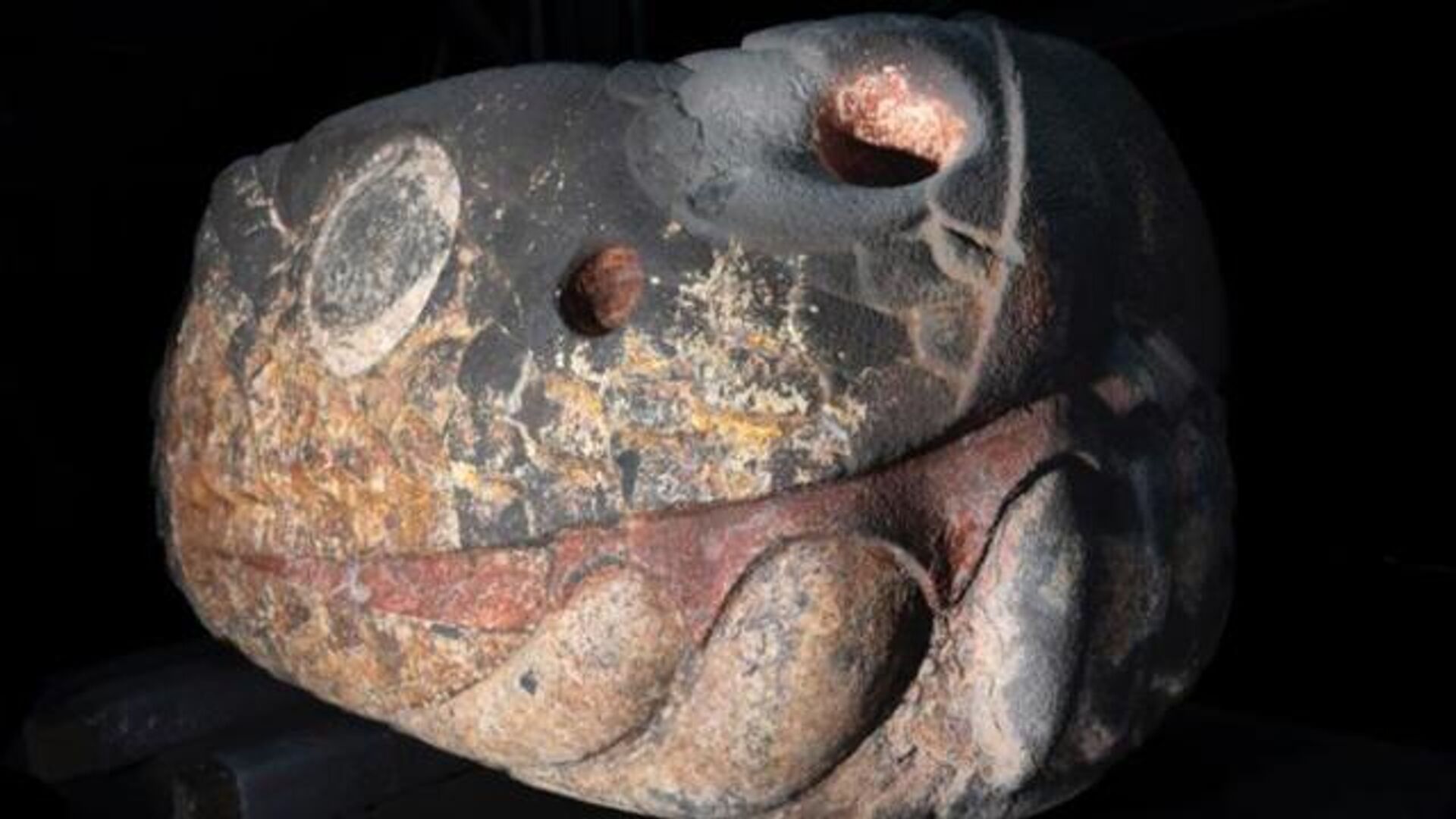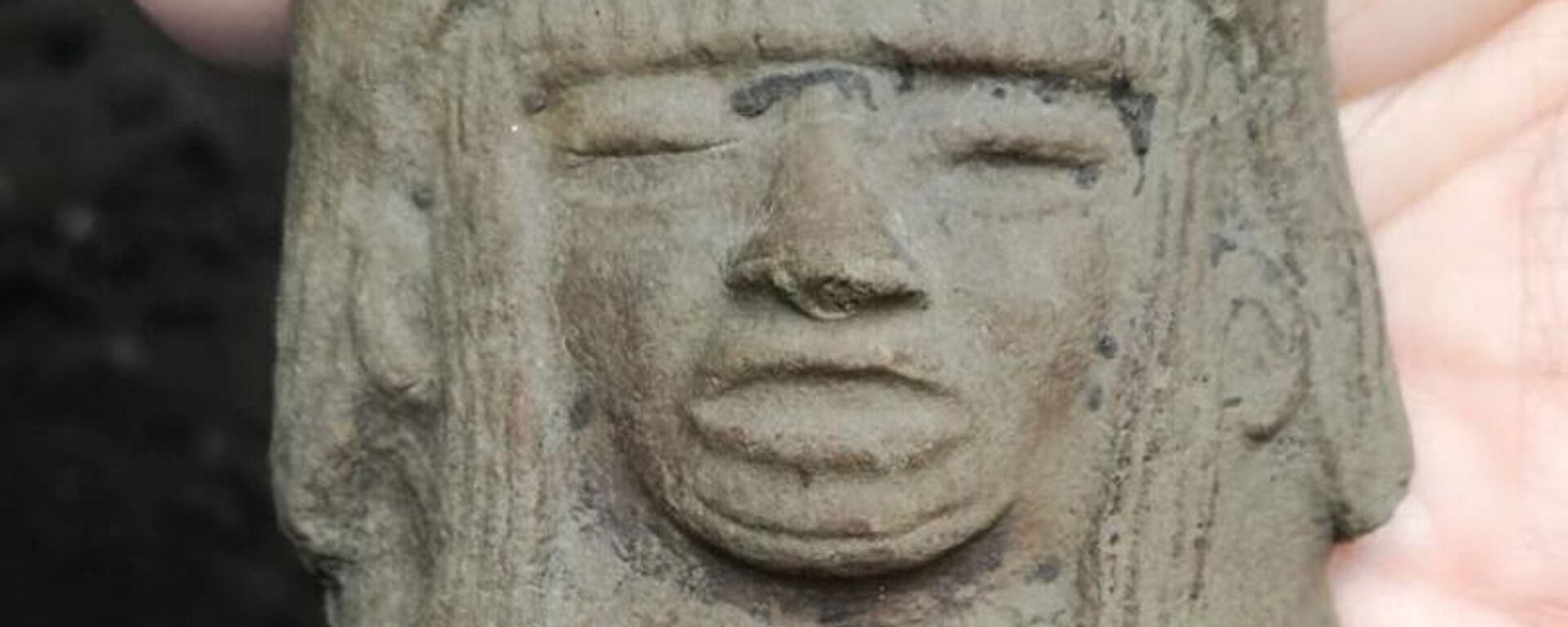https://sputnikglobe.com/20231021/earthquake-unearths-giant-aztec-sculpted-snakehead-relic-in-mexico-1114378527.html
Earthquake Unearths Giant Aztec Sculpted Snakehead Relic in Mexico
Earthquake Unearths Giant Aztec Sculpted Snakehead Relic in Mexico
Sputnik International
A seismic event 2022 uncovered an astonishing relic beneath a contemporary law school in Mexico City - an enormous, vividly adorned snakehead with roots tracing back to the Aztec Empire.
2023-10-21T14:05+0000
2023-10-21T14:05+0000
2023-10-21T14:05+0000
beyond politics
mexico
mexico city
tenochtitlan
national autonomous university of mexico
california state university
https://cdn1.img.sputnikglobe.com/img/07e7/0a/15/1114379084_0:0:640:360_1920x0_80_0_0_96610b11e9dae18f9ca9aba37a569408.jpg
The tremors of a magnitude-7.6 earthquake reverberating through Mexico City on September 19, 2022 did not only alter the physical terrain, as the seismic jolt also unearthed a serpent-headed sculpture tucked beneath the edifice housing a law school affiliated with the National Autonomous University of Mexico. This discovery offered a poignant glimpse into the city's ancient past.This revelation was formally disclosed by Mexico's National Institute of Anthropology and History (INAH - el Instituto Nacional de Antropologia e Historia). With a legacy dating back more than half a millennium, the snakehead unfurls in the annals of history, originating in an epoch when the Aztecs held dominion over what would eventually evolve into the pulsating core of Tenochtitlan's bustling capital.The astonishing serpent sculpture revealed by the INAH has left art connoisseurs awe-inspired. This masterpiece carries a weighty presence, measuring 5.9 ft in length, 2.8 ft in width, and 3.3 ft in height, tipping the scales at approximately 1,300 kg. What truly sets it aglow, however, is the vivid interplay of colors adorning its surface, from fiery reds to tranquil blues juxtaposed with deep blacks and crisp whites.In the heart of ancient Mexico, the Aztecs crafted towering temples and grand pyramids, their devotion extending to a pantheon of deities. Among these, Quetzalcoatl, a revered god often symbolized as a serpent, held a prominent place.Nevertheless, this sculpture remains shrouded in mystery amidst the relics scooped up, leaving archaeologists pondering its true origin.Close to 80 percent of the sculpture's surface retained its original, vibrant hues, a testament to painstaking preservation techniques. With precision and care, an adept National Institute of Anthropology and History team skillfully raised the serpent's head from its earthen abode using a crane. Subsequently, they artfully enveloped the sculpture in a custom-made humidity chamber, safeguarding its visual splendor.This ingenious chamber serves as the stage for the sculpture's gradual dehumidification process, ensuring the retention of its original colors. Maria Barajas Rocha, a distinguished conservationist collaborating with the INAH, expounded on the significance of this thorough procedure, as conveyed in an official statement.Erika Robles Cortes, an archaeologist affiliated with the National Institute of Anthropology and History, emphasized the significance of the sculpted snakehead found at Tenochtitlan, owing to its remarkably well-preserved colors. Although similar artifacts have been dug up at the site, this find stands out for its vivid colorings, shedding light on the artistic prowess of ancient Mesoamerican civilizations.
https://sputnikglobe.com/20230808/photos-ruins-burial-site-of-ancient-pre-aztec-village-discovered-under-mexico-city-1112471806.html
mexico
mexico city
tenochtitlan
Sputnik International
feedback@sputniknews.com
+74956456601
MIA „Rossiya Segodnya“
2023
Chimauchem Nwosu
https://cdn1.img.sputnikglobe.com/img/07e7/09/01/1113046371_0:99:1536:1635_100x100_80_0_0_9c5c627283eca931c39fe4852bbb301c.jpg
Chimauchem Nwosu
https://cdn1.img.sputnikglobe.com/img/07e7/09/01/1113046371_0:99:1536:1635_100x100_80_0_0_9c5c627283eca931c39fe4852bbb301c.jpg
News
en_EN
Sputnik International
feedback@sputniknews.com
+74956456601
MIA „Rossiya Segodnya“
Sputnik International
feedback@sputniknews.com
+74956456601
MIA „Rossiya Segodnya“
Chimauchem Nwosu
https://cdn1.img.sputnikglobe.com/img/07e7/09/01/1113046371_0:99:1536:1635_100x100_80_0_0_9c5c627283eca931c39fe4852bbb301c.jpg
sculpted snakehead, snakehead sculpture, unearthed serpentine head relic in mexico, magnitude-7.6 earthquake, mexico city, september 19 2022 mexican earthquake, serpent-headed sculpture, national autonomous university of mexico, national institute of anthropology and history, inah, aztecs, tenochtitlan, quetzalcoatl, artistry, preservation techniques, dehumidification process, maria barajas rocha, erika robles cortes, ancient mesoamerican civilizations, frances berdan.
sculpted snakehead, snakehead sculpture, unearthed serpentine head relic in mexico, magnitude-7.6 earthquake, mexico city, september 19 2022 mexican earthquake, serpent-headed sculpture, national autonomous university of mexico, national institute of anthropology and history, inah, aztecs, tenochtitlan, quetzalcoatl, artistry, preservation techniques, dehumidification process, maria barajas rocha, erika robles cortes, ancient mesoamerican civilizations, frances berdan.
Earthquake Unearths Giant Aztec Sculpted Snakehead Relic in Mexico
A seismic event in 2022 uncovered an astonishing relic beneath a building of a law school in Mexico City - an enormous, vividly adorned snakehead with roots tracing back to the Aztec Empire.
The tremors of a magnitude-7.6 earthquake reverberating through Mexico City on September 19, 2022 did not only alter the physical terrain, as the seismic jolt also unearthed a serpent-headed sculpture tucked beneath the edifice housing a law school affiliated with the National Autonomous University of Mexico. This discovery offered a poignant glimpse into the city's ancient past.
This revelation was formally disclosed by Mexico's National Institute of Anthropology and History (INAH - el Instituto Nacional de Antropologia e Historia). With a legacy dating back more than half a millennium, the snakehead unfurls in the
annals of history, originating in an epoch when the Aztecs held dominion over what would eventually evolve into the pulsating core of Tenochtitlan's bustling capital.
The astonishing serpent sculpture revealed by the INAH has left art connoisseurs awe-inspired. This masterpiece carries a weighty presence, measuring 5.9 ft in length, 2.8 ft in width, and 3.3 ft in height, tipping the scales at approximately 1,300 kg. What truly sets it aglow, however, is the vivid interplay of colors adorning its surface, from fiery reds to tranquil blues juxtaposed with deep blacks and crisp whites.
In the heart of ancient Mexico, the
Aztecs crafted towering temples and
grand pyramids, their devotion extending to a pantheon of deities. Among these, Quetzalcoatl, a revered god often symbolized as a serpent, held a prominent place.
Nevertheless, this sculpture remains shrouded in mystery amidst the relics scooped up, leaving archaeologists pondering its true origin.
Close to 80 percent of the sculpture's surface retained its original, vibrant hues, a testament to
painstaking preservation techniques. With precision and care, an adept National Institute of Anthropology and History team skillfully raised the serpent's head from its earthen abode using a crane. Subsequently, they artfully enveloped the sculpture in a custom-made humidity chamber, safeguarding its visual splendor.
This ingenious chamber serves as the stage for the sculpture's gradual dehumidification process, ensuring the retention of its original colors. Maria Barajas Rocha, a distinguished conservationist collaborating with the INAH, expounded on the significance of this thorough procedure, as conveyed in an official statement.
Erika Robles Cortes, an archaeologist affiliated with the National Institute of Anthropology and History, emphasized the significance of the sculpted snakehead found at Tenochtitlan, owing to its remarkably well-preserved colors. Although
similar artifacts have been dug up at the site, this find stands out for its vivid colorings, shedding light on the artistic prowess of ancient Mesoamerican civilizations.
The snakehead’s "sheer size is impressive… The survival of black, white, red, yellow, and blue paints is particularly interesting — one gains a good image of the visual impact of such sculptures as they were arrayed about the city center," remarked Frances Berdan, a professor emeritus of anthropology at California State University, San Bernardino, and part of the excavation team.




